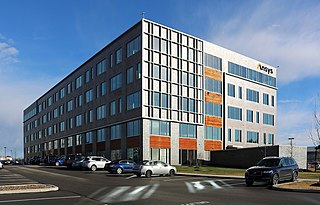
Adobe FrameMaker is a document processor designed for writing and editing large or complex documents, including structured documents. It was originally developed by Frame Technology Corporation, which was bought by Adobe.

Db2 is a family of data management products, including database servers, developed by IBM. They initially supported the relational model, but were extended to support object-relational features and non-relational structures like JSON and XML. The brand name was originally styled as DB/2, then DB2 until 2017 and finally changed to its present form.

A point cloud is a set of data points in space. The points represent a 3D shape or object. Each point has its set of X, Y and Z coordinates. Point clouds are generally produced by 3D scanners or by photogrammetry software, which measure many points on the external surfaces of objects around them. As the output of 3D scanning processes, point clouds are used for many purposes, including to create 3D CAD models for manufactured parts, for metrology and quality inspection, and for a multitude of visualization, animation, rendering and mass customization applications.
Autodesk, Inc. is an American multinational software corporation that makes software products and services for the architecture, engineering, construction, manufacturing, media, education, and entertainment industries. Autodesk is headquartered in San Rafael, California, and features a gallery of its customers' work in its San Francisco building. The company has offices worldwide. Its U.S. locations are California, Oregon, Colorado, Texas, Michigan, New Hampshire and Massachusetts. Its Canada offices are located in Ontario, Quebec, and Alberta.
Creo Elements/Pro, not to be confused with Creo Elements/Direct Modeling, which was formerly known, together with Creo Parametric, as Pro/Engineer and Wildfire, is a solid modeling or CAD, CAM, CAE, and associative 3D modeling application, running on Microsoft Windows.

In industry, product lifecycle management (PLM) is the process of managing the entire lifecycle of a product from inception, through engineering design and manufacture, to service and disposal of manufactured products. PLM integrates people, data, processes and business systems and provides a product information backbone for companies and their extended enterprise.

Ansys, Inc. is an American company based in Canonsburg, Pennsylvania. It develops and markets multiphysics engineering simulation software for product design, testing and operation and offers its products and services to customers worldwide. Ansys was founded in 1970 by John Swanson. Swanson sold his interest in the company to venture capitalists in 1993. Ansys went public on NASDAQ in 1996. In the 2000s, Ansys made numerous acquisitions of other engineering design companies, acquiring additional technology for fluid dynamics, electronics design, and other physics analysis. Ansys became a component of the NASDAQ-100 index on December 23, 2019.

3D scanning is the process of analyzing a real-world object or environment to collect data on its shape and possibly its appearance. The collected data can then be used to construct digital 3D models.
The Blue Brain Project is a Swiss brain research initiative that aims to create a digital reconstruction of rodent and eventually human brains by reverse-engineering mammalian brain circuitry. The project was founded in May 2005 by the Brain and Mind Institute of École Polytechnique Fédérale de Lausanne (EPFL) in Switzerland. Its mission is to use biologically-detailed digital reconstructions and simulations of the mammalian brain to identify the fundamental principles of brain structure and function.

MeshLab is a 3D mesh processing software system that is oriented to the management and processing of unstructured large meshes and provides a set of tools for editing, cleaning, healing, inspecting, rendering, and converting these kinds of meshes. MeshLab is free and open-source software, subject to the requirements of the GNU General Public License (GPL), version 2 or later, and is used as both a complete package and a library powering other software. It is well known in the more technical fields of 3D development and data handling.

Photosynth is a discontinued app and service from Microsoft Live Labs and the University of Washington that analyzes digital photographs and generates a three-dimensional model of the photos and a point cloud of a photographed object. Pattern recognition components compare portions of images to create points, which are then compared to convert the image into a model. Users are able to view and generate their own models using a software tool available for download at the Photosynth website.
TurboCAD is a CAD software application for 2D and 3D design and drafting which runs on Macintosh and Microsoft Windows operating systems.

Cloud computing is the on-demand availability of computer system resources, especially data storage and computing power, without direct active management by the user. The term is generally used to describe data centers available to many users over the Internet. Large clouds, predominant today, often have functions distributed over multiple locations from central servers. If the connection to the user is relatively close, it may be designated an edge server.
3D data acquisition and reconstruction is the generation of three-dimensional or spatiotemporal models from sensor data. The techniques and theories, generally speaking, work with most or all sensor types including optical, acoustic, laser scanning, radar, thermal, seismic.

Altium Designer is a PCB and electronic design automation software package for printed circuit boards. It is developed by Australian software company Altium Limited.

The Point Cloud Library (PCL) is an open-source library of algorithms for point cloud processing tasks and 3D geometry processing, such as occur in three-dimensional computer vision. The library contains algorithms for filtering, feature estimation, surface reconstruction, 3D registration, model fitting, object recognition, and segmentation. Each module is implemented as a smaller library that can be compiled separately. PCL has its own data format for storing point clouds - PCD, but also allows datasets to be loaded and saved in many other formats. It is written in C++ and released under the BSD license.
Microservice architecture – a variant of the service-oriented architecture (SOA) structural style – arranges an application as a collection of loosely coupled services. In a microservices architecture, services are fine-grained and the protocols are lightweight.
Digital archaeology is the application of information technology and digital media to archaeology. It includes the use of digital photography, 3D reconstruction, virtual reality, and geographical information systems, among other techniques. Computational archaeology, which covers computer-based analytical methods, can be considered a subfield of digital archaeology, as can virtual archaeology.
3DF Zephyr is a commercial photogrammetry and 3D modeling software. Developed and marketed by the Italian software house 3DFLOW, 3DF Zephyr was first released in January 2014 and continuously updated since then. It's a complete photogrammetry pipeline software package that includes many post processing tools for post processing, measurements, 3D modeling and content creation. It allows 3D reconstruction from both photos or videos, by automatically extracting frames and selecting those most suitable for the computation.

Vectorworks, Inc. is a software development company that focuses on CAD and BIM software for the architecture, engineering, and construction (AEC), landscape, and entertainment industries.











